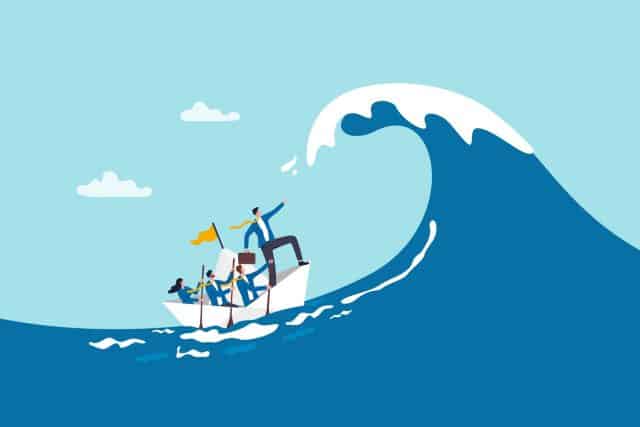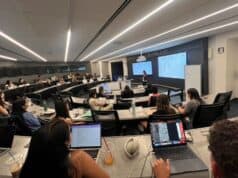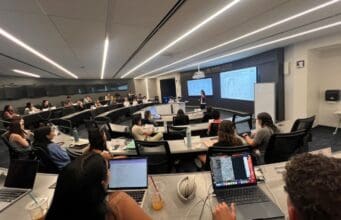Article contributed by Jay Weiser 92MBA, Principal and Founder of Jay Weiser Consulting.
Disruption and uncertainty are nothing new. They’ve been around since the beginning of time: think the ice age, volcanos, the rise of agriculture, Gutenberg’s printing press, the Industrial Revolution, the launch of the internet…you get my point. Yet the frequency and severity of disruptions and the resulting uncertainty that inevitably follows have increased in recent years due to factors like the increasing pace of technological innovation, geopolitical instability, global economics, social justice movements, climate change, and more.
No wonder leaders feel stressed.
Why Are Disruptions and Uncertainty a Problem?
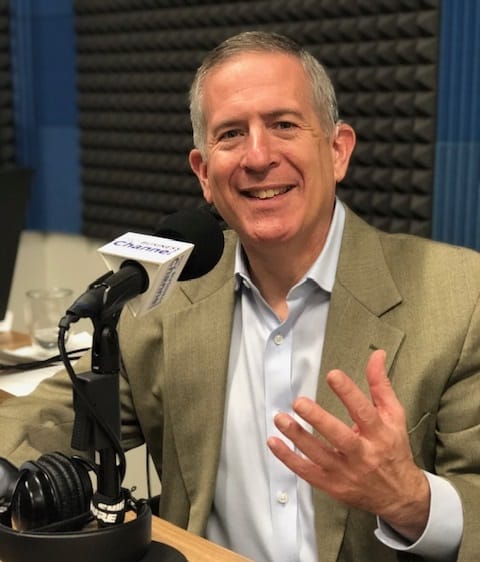
Disruptions and crises have a nasty habit of appearing unannounced, catching us off-guard. However, in many cases, we should have been aware of, monitored, assessed, and acted on early warning signals.
Unfortunately, the truth is that we rarely work to understand and address emerging challenges or new business models proactively. Remember, not all disruptions are acts of nature or even necessarily sudden or damaging. Some creep up slowly, unnoticed, or are left unaddressed until it is too late.
Given our interdependent and interconnected world, the impact of this negligence is significant. Consider the secondary and tertiary impacts of COVID-19 that are still occurring, while in the last year, the Ukraine conflict and global economic pressures were added to the mix. Unsurprisingly, the new word at the World Economic Forum in Davos was “poly-crisis,” multiple interconnected crises occurring simultaneously.
Given the extreme focus on efficiency and short-term results over the last decade, we did not consider or see the value in preparation and building resilience. Why would we? We were humming away. Even now, when the last two and a half years should have taught us a lesson, we still make excuses that we are too busy fighting fires or don’t have the time or resources to prepare for the future. Then when things do happen, we claim we are victims of conditions we could not have foreseen or controlled. In truth, that is rarely the case.
The Challenge
While we cannot choose our circumstances, we can decide how to respond (preemptively or reactively). Start by answering a few key questions:
- How do we prepare for a disruptive and uncertain future, so we not only survive, but thrive?
- What capabilities must leaders and organizations build and sustain to do this?
- What organizational attributes are necessary?
The Solution
The fact is, what’s made leaders and organizations succeed in the past is no longer enough in the face of disruption and uncertainty. New leadership capabilities are needed to help organizations prepare, adapt and act to succeed. The key to finding solutions is seeing, thinking, and doing things differently. But, how do we do this? To succeed in a world of accelerating change, frequent disruptions, and rampant uncertainty, leaders must effectively navigate five distinct but interrelated and interdependent tensions. The Five Leadership Superpowers™ capability framework was developed based on both/and (vs. either/or) thinking to address this challenge.
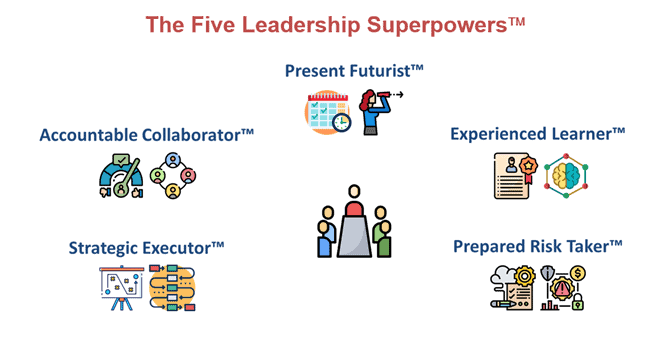
Present Futurist™
This team member:
- Builds a (more) robust understanding of the present, considering factors internal and external to the organization.
- Envisions where they want the organization to go in the future.
- Scans the environment to sense, anticipate, and build awareness of emerging trends and other market signals. Combines these to develop alternative scenarios.
- Synthesizes present and future insights to inform decision-making.
- Understands that balancing tensions between the present and future is vital to long-term success.
Experienced Learner™
This team member:
- Acknowledges that experience and expertise are often insufficient to succeed in novel, disruptive, uncertain environments.
- Augments experience and expertise with a curious mindset; asks great questions and challenges existing practices and assumptions. Fosters the same behaviors in others.
- Practices lifelong learning, knowing it is essential to understand and address future challenges and opportunities.
- Continuously improves learning capabilities (gets better at learning itself).
- Embraces novel situations, no longer fears or avoids them.
Prepared Risk Taker™
This team member:
- Knows that risk-taking is an essential element of competing, experiments, and places small bets to learn.
- Improves risk awareness considering the interdependencies and interconnections between risks.
- Uses system thinking to assess secondary and tertiary impacts.
- Considers a range of “what if” scenarios to identify risks to key drivers.
- Improves organizational readiness and resilience to prepare for, manage and mitigate risks, withstand disruptions better, recover faster, and accelerate forward.
- Uses this information to enable faster, more-informed decision-making and actions to dampen downside risks and amplify upside potential.
Strategic Executor™
This team member:
- Manages focus between short- and long-term views of the business.
- Balances strategy and execution (operations), knowing they are inextricably linked.
- Excels at operational execution while maintaining focus on longer-term strategy.
- Recognizes short-term decisions/choices made under pressure can adversely impact future options and performance.
- Considers long-term implications before making short-term decisions, and strives not to impair future performance when conditions improve.
Accountable Collaborator™
This team member:
- Recognizes that addressing tomorrow’s challenges and opportunities frequently requires collaboration across functions, multiple teams, and even organizational boundaries in pursuit of common objectives.
- Demonstrates, supports, encourages, and expects collaboration between and among all parties.
- Supports and drives collective accountability for achieving critical outcomes and individual accountability between and among team members for actions and intermediate results.
- Forms dynamic, fit-for-purpose, weblike collaborative organizations (often temporary) that supersede existing organizational structure to achieve outcomes.
Collectively, The Five Leadership Superpowers™ inform and support one another. A leadership team (at whatever level) should strive for proficiency in all five, while individual leaders should strive for proficiency in one to three while building an appreciation and understanding for the others. By becoming Superpowered, an organization is enabled to see things sooner, make better, faster, more informed decisions and act faster. This results in greater value creation for all stakeholders.
About the Author
Jay Weiser 92MBA is the Principal and Founder of Jay Weiser Consulting (JWC). Fueled by a passion for helping clients reach their potential, he enables leadership teams and their organizations to survive and thrive in the face of disruption and uncertainty. JWC’s offerings span from keynote talks and education programs to leadership and organizational assessments and advisory and coaching services to help leaders and organizations accelerate on their journey to becoming Superpowered.
You can reach Jay by connecting with him on LinkedIn, emailing him, or scheduling a complimentary discovery session. Parts of this article were previously published on Reworked.co in an article titled Thriving in Turbulent Times: The Five Leadership Superpowers – The Present Futurist.


